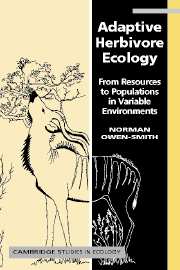Book contents
- Frontmatter
- Contents
- Acknowledgements
- Acronym and symbol conventions
- 1 Conceptual origins : variability in time and space
- 2 Consumer–resource models : theory and formulation
- 3 Resource abundance : intake response and time frames
- 4 Resource distribution : patch scales and depletion
- 5 Resource quality : nutritional gain and diet choice
- 6 Resource constraints : physiological capacities and costs
- 7 Resource allocation : growth, storage and reproduction
- 8 Resource production : regeneration and attrition
- 9 Resource competition : exploitation and density dependence
- 10 Resource-dependent mortality : nutrition, predation and demography
- 11 Habitat suitability : resource components and stocking densities
- 12 Resource partitioning : competition and coexistence
- 13 Population dynamics : resource basis for instability
- 14 An adaptive resource ecology : foundation and prospects
- References
- Index
6 - Resource constraints : physiological capacities and costs
Published online by Cambridge University Press: 04 February 2011
- Frontmatter
- Contents
- Acknowledgements
- Acronym and symbol conventions
- 1 Conceptual origins : variability in time and space
- 2 Consumer–resource models : theory and formulation
- 3 Resource abundance : intake response and time frames
- 4 Resource distribution : patch scales and depletion
- 5 Resource quality : nutritional gain and diet choice
- 6 Resource constraints : physiological capacities and costs
- 7 Resource allocation : growth, storage and reproduction
- 8 Resource production : regeneration and attrition
- 9 Resource competition : exploitation and density dependence
- 10 Resource-dependent mortality : nutrition, predation and demography
- 11 Habitat suitability : resource components and stocking densities
- 12 Resource partitioning : competition and coexistence
- 13 Population dynamics : resource basis for instability
- 14 An adaptive resource ecology : foundation and prospects
- References
- Index
Summary
In Chapter 5, we recognised tradeoffs between short-term constraints on the rate of nutritional gain, as governed by handling time during food ingestion, and the longer-term constraint imposed by digestive processing capacity. Additional limitations on daily food intake are imposed by foraging time, as affected by environmental conditions and other factors, and metabolic processing capacity. In this chapter, attention is focussed on how these physiological constraints limit resource gains. Optimization becomes not so much a matter of maximizing rates of gain, but of balancing multiple constraints varying over time in their effectiveness.
Standard computational techniques have been developed for identifying the best course of action, in circumstances where multiple constraints apply. These generally represent constraints as fixed upper or lower limits, which cannot be exceeded. In practice, physiological limitations are somewhat elastic, as well as changing over time. Nevertheless, costs are incurred when physiological limitations are stretched, which have to be weighed against the resultant benefits. Limitations on physiological capacity act to restrict the maximum rates of food intake and nutritional gain that can be achieved, over extended time periods. Costs may also act to increase metabolic losses, relative to nutrient gains, or reduce the effective conversion efficiency from food to consumer biomass. In terms of the GMM model, the difference between the relative rate of biomass gain, G, and the rate of metabolic attrition in biomass, Mp, provides an overall measure of the rate efficiency with which resources are converted into biomass growth potential (cf. Equations 2.18 and 2.28).
- Type
- Chapter
- Information
- Adaptive Herbivore EcologyFrom Resources to Populations in Variable Environments, pp. 110 - 135Publisher: Cambridge University PressPrint publication year: 2002



